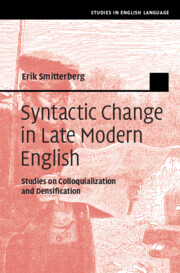Book contents
- Syntactic Change in Late Modern English
- Studies In English Language
- Syntactic Change in Late Modern English
- Copyright page
- Contents
- Figures
- Tables
- Acknowledgements
- Chapter 1 Introduction
- Chapter 2 Sociocultural and Linguistic Change in Late Modern English
- Chapter 3 Aspects of Language Change
- Chapter 4 Methodological Framework
- Chapter 5 Colloquialization I: Not-Contraction
- Chapter 6 Colloquialization II: Co-ordination by And
- Chapter 7 Densification I: Nouns as Premodifiers in Noun Phrases
- Chapter 8 Densification II: Participle Clauses as Postmodifiers in Noun Phrases
- Chapter 9 Concluding Discussion
- Appendix
- References
- Index
Chapter 3 - Aspects of Language Change
Published online by Cambridge University Press: 19 November 2021
- Syntactic Change in Late Modern English
- Studies In English Language
- Syntactic Change in Late Modern English
- Copyright page
- Contents
- Figures
- Tables
- Acknowledgements
- Chapter 1 Introduction
- Chapter 2 Sociocultural and Linguistic Change in Late Modern English
- Chapter 3 Aspects of Language Change
- Chapter 4 Methodological Framework
- Chapter 5 Colloquialization I: Not-Contraction
- Chapter 6 Colloquialization II: Co-ordination by And
- Chapter 7 Densification I: Nouns as Premodifiers in Noun Phrases
- Chapter 8 Densification II: Participle Clauses as Postmodifiers in Noun Phrases
- Chapter 9 Concluding Discussion
- Appendix
- References
- Index
Summary
In this chapter, the stability paradox is resolved. It is demonstrated that the idiolect is the true locus of language change. Language change can be of three basic types: independent innovation, propagation, and propagation-dependent innovation. Independent innovation is the type that is most likely to lead to structural change, but it does not correlate with social factors like network ties. The apparent stability of Late Modern English is due to a large number of idiolects undergoing change that mostly consists in propagation and propagation-dependent innovation. As most of the changes are the result of idiolects adopting features that existed in other idiolects already, these changes do not typically alter the structure of the communal language. Moreover, the emergence of Standard English both provided an existing target for which many speakers aimed and concealed a great deal of the variation that did occur through its predominance in printed texts.
Keywords
- Type
- Chapter
- Information
- Syntactic Change in Late Modern EnglishStudies on Colloquialization and Densification, pp. 42 - 76Publisher: Cambridge University PressPrint publication year: 2021

